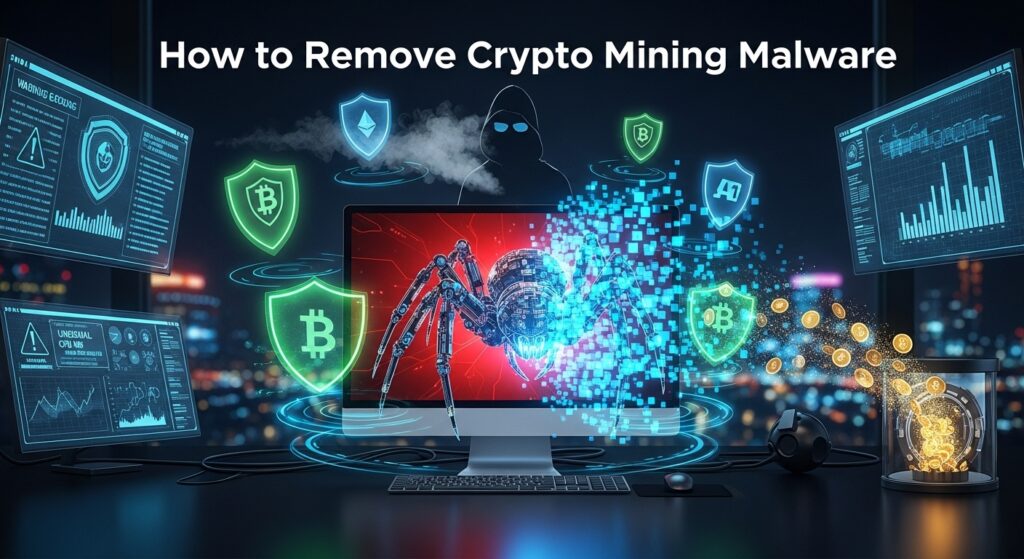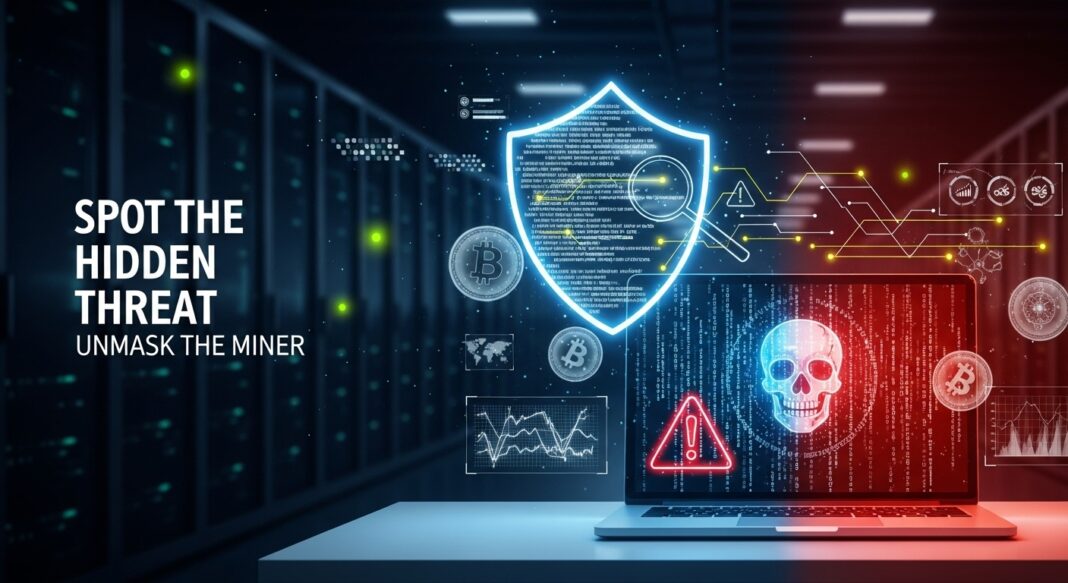Crypto mining malware, also known as cryptojacking, is a growing threat that can turn your devices into unauthorized cryptocurrency mining machines. This overview will help you understand what crypto mining malware is, how to detect it, how to remove it, and how to prevent it from happening again. By following these steps, you can protect your devices and keep your digital life secure.
What is Crypto Mining Malware?
Crypto mining malware is malicious software that hijacks your computer’s or mobile device’s processing power to mine cryptocurrencies like Bitcoin or Monero without your permission. This process, called cryptojacking, uses your device’s CPU (or sometimes GPU) to perform complex calculations needed for mining. Unlike legitimate mining, where miners use their own hardware, cryptojacking exploits your resources for someone else’s profit.
- How it works: The malware runs in the background, often unnoticed, using your device’s power to solve cryptographic puzzles. Once solved, the mined cryptocurrency goes to the attacker’s wallet.
- Types of malware: It can be file-based (e.g., Trojan.BitCoinMiner) or browser-based (e.g., CoinHive scripts). File-based malware is installed on your device, while browser-based scripts run when you visit compromised websites.
- Why it’s a problem: It slows down your device, increases your electricity bills, and can damage hardware due to overheating. A 2023 Fortinet report noted that 56% of cryptojacking infections come from phishing emails.
Signs of Crypto Mining Malware Infection
Detecting crypto mining malware early is crucial. Here are the most common signs that your device might be infected:
- High CPU Usage: If your CPU usage is consistently high (80-100%) even when you’re not running demanding programs, it could be a sign of mining malware. Check this in Task Manager (Windows: Ctrl+Shift+Esc, “Performance” tab) or Activity Monitor (Mac: Utilities, CPU tab).
- Overheating: Your device may feel unusually hot, or the fans may run louder than usual. This happens because mining is resource-intensive and generates heat, potentially reducing hardware lifespan.
- Slow Performance: If your device is sluggish, freezing, or showing “Not Responding” messages, malware could be using up its resources. This can make even simple tasks like browsing or opening files slow.
- Unexpected Pop-ups: Frequent ads, redirects to suspicious websites, or new browser extensions you didn’t install can indicate malware. These often come with browser-based cryptojacking scripts.
- Unexplained Electricity Bill Increase: Mining consumes a lot of power. A 2025 Trend Micro report suggests electricity bills can increase by up to 50% due to cryptojacking. The U.S. Energy Information Administration (EIA) estimates crypto mining consumes 2.3% of U.S. electricity.
| Sign | Description | How to Check |
|---|---|---|
| High CPU Usage | CPU runs at 80-100% when idle | Task Manager (Windows) or Activity Monitor (Mac) |
| Overheating | Device feels hot, fans run loudly | Touch device case, listen for fan noise |
| Slow Performance | Sluggish programs, lag in tasks | Observe delays or freezing during use |
| Unexpected Pop-ups | Ads, redirects, or new extensions | Check browser for unusual activity |
| Electricity Bill Increase | Bills rise without clear reason | Review recent electricity bills |
Is Crypto Mining Profitable in 2025? A Comprehensive Guide
How to Detect Crypto Mining Malware
To detect crypto mining malware, you can use several tools and methods. Here are the most effective ones:
- Antivirus Software: Use trusted antivirus programs like McAfee (mcafee.com), Norton (norton.com), Bitdefender (bitdefender.com), or Malwarebytes (malwarebytes.com). These tools can scan your system for malware and block cryptojacking attempts. Look for features like real-time protection, behavioral analysis, and anti-ransomware capabilities.
- Browser Extensions: Install extensions like MinerBlock (Chrome Web Store) or No Coin (GitHub). These block in-browser mining scripts that run when you visit compromised websites. They are lightweight and easy to use.
- Online Scanners: Tools like VirusTotal (virustotal.com) or PublicWWW (publicwww.com) can scan files or your entire system for malware. Avoid uploading sensitive data to these services.
- Network Monitoring Tools: Use tools like Wireshark (wireshark.org) or GlassWire (glasswire.com) to monitor network activity. Unusual traffic or connections to suspicious domains (e.g., coinhive.com, minergate.com) can indicate mining malware.
| Tool Type | Examples | Benefits |
|---|---|---|
| Antivirus Software | McAfee, Norton, Bitdefender, Malwarebytes | Real-time scanning, behavioral analysis, removes threats |
| Browser Extensions | MinerBlock, No Coin | Blocks in-browser mining, lightweight, easy to use |
| Online Scanners | VirusTotal, PublicWWW | Scans files/systems, no installation needed |
| Network Monitoring | Wireshark, GlassWire | Detects unusual network activity, detailed analysis |
How to Remove Crypto Mining Malware

If you suspect your device is infected, follow these steps to remove the malware:
- Quarantine and Delete Suspicious Files: Use your antivirus software to identify and quarantine files like “coinminer.exe” or “cryptojack.js.” Delete them from the quarantine section to ensure they’re removed.
- Run a Full System Scan: Update your antivirus software and perform a full system scan. Ensure the software has the latest definitions to detect recent threats. Remove any detected threats.
- Clear Browser Cache and Cookies: Go to your browser settings, find the privacy section, and clear all cached data and cookies to remove malicious scripts.
- Reset Browser Settings: Reset your browser to its default settings to remove any unwanted extensions or changes made by the malware. This can be done in the browser’s settings menu.
- Disconnect from the Internet: During the removal process, turn off Wi-Fi or disconnect your Ethernet cable to prevent the malware from communicating with its command center.
- Monitor CPU Usage: After removal, check your CPU usage in Task Manager or Activity Monitor to ensure it returns to normal.
- System Restore (Last Resort): If all else fails, use system restore to revert your device to a point before the infection. Note that this may delete recent files, so use it only if necessary.
How to Prevent Crypto Mining Malware
Prevention is better than cure. Here are some steps to keep your devices safe:
- Be Cautious When Browsing: Avoid visiting suspicious websites and always use HTTPS. Install ad blockers to prevent malicious ads. A 2023 Check Point survey found that 75% of IT professionals consider crypto mining malware a top threat.
- Scrutinize Downloads: Only download software from trusted sources. Be wary of “.exe” files from unknown websites, as they are a common infection method.
- Keep Software Updated: Regularly update your operating system and applications to patch security vulnerabilities. Unpatched software, like the EternalBlue exploit, is often used to deploy crypto mining malware.
- Use Strong Passwords: Use unique, strong passwords for all accounts and consider a password manager for added security.
- Install Reputable Antivirus Software: Use antivirus and anti-malware tools with real-time scanning. Keep them updated to protect against the latest threats.
Is Crypto Mining Malware Dangerous?
Yes, crypto mining malware can be dangerous in several ways:
- Hardware Damage: Continuous high CPU usage can cause overheating, which may reduce your device’s lifespan or cause permanent damage to components like the CPU or GPU.
- Increased Electricity Costs: Mining is energy-intensive, leading to higher electricity bills. A 2025 EIA report notes that crypto mining consumes significant power, impacting household budgets.
- Privacy Concerns: Some malware may also steal personal information or install other types of malware, compromising your data.
- Legal Implications: Using someone else’s device for mining without permission is illegal and can lead to legal consequences.
Frequently Asked Questions (FAQs)
Q: What is cryptojacking?
A: Cryptojacking is the unauthorized use of someone else’s computing resources to mine cryptocurrencies. It can happen through malware installed on your device or malicious scripts running in your browser.
Q: How can I tell if my device is being used for crypto mining?
A: Look for signs like high CPU usage, overheating, slow performance, unexpected pop-ups, and increased electricity bills. Use Task Manager or Activity Monitor to check CPU usage.
Q: Can crypto mining malware infect mobile devices?
A: Yes, it can infect mobile devices, though it’s less common due to lower processing power. Use antivirus apps on your phone to stay protected.
Q: Is it legal to mine cryptocurrency on someone else’s device?
A: No, it’s illegal and considered theft. Always ensure you have permission before using someone else’s resources.
Final Thoughts
Crypto mining malware is a sneaky and persistent threat, but with the right knowledge and tools, you can detect, remove, and prevent it. Regularly monitor your device’s performance, use trusted security software, and stay cautious online. By following this guide, you can safeguard your devices and avoid becoming a victim of cryptojacking.

